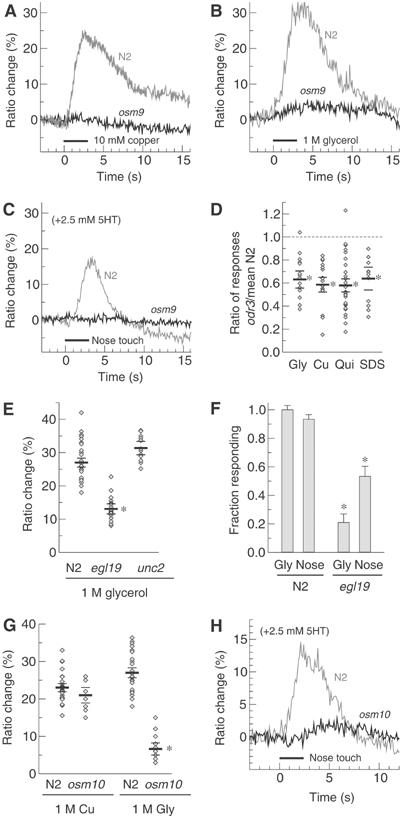Figure 4.

(A, B) The TRPV-related channel OSM-9 is required for repellent-induced calcium transients. (A) Typical responses of N2 (gray line) and osm-9 (black line) animals to 10 mM Cu2+ and (B) 1 M glycerol are shown. No significant repellent-induced calcium transients have been observed in osm-9 with any repellent. Black bars indicate duration of application of the stimulus. (C) OSM-9 is also required for calcium transients induced by nose touch. (D) Mutation in the G-protein odr-3 reduces response to all repellents. Individual responses are indicated as diamonds. Horizontal bars represent the mean±s.e.m. of the repellent response as a fraction of the mean wild-type response; n⩾6 animals for each condition; reduction is significant in each case (*P<0.001). (E) L-type channels are a major source of observed calcium transients. Individual responses to 1 M glycerol (diamonds) and mean±s.e.m. (horizontal bars) are shown for wild-type, egl-19(ad1006) and unc-2(mu74) strains. A significant reduction is observed for the loss-of-function allele of the L-type channel EGL-19 (P<0.001, asterisk), but not for a putative null of the worm non-L-type channel UNC-2. n⩾7 animals for each condition. (F) Wild-type worms give reliable behavioral responses to 1 M glycerol and nose touch (left bars). egl-19(ad1006) worms give significantly reduced behavioral responses (P<0.01, asterisk), consistent with the reduced calcium transient observed in (E). A minimum of 60 trials were used for each condition, except glycerol on N2 for which 30 trials were used. Error bars indicate expected s.e.m. given observed response rate. (G) osm-10 mutants have a specific deficit for response to high-osmotic shock (1 M glycerol) but not Cu2+. Individual responses (diamonds) and mean±s.e.m. (horizontal lines) are shown. The asterisk indicates a significant difference from wild type (P<0.001). Sample sizes: n=19, wild-type Cu2+; n=5, osm-10 Cu2+; n=12, wild-type gly; n=7, osm-10 gly. (H) Nose touch is diminished in osm-10 mutants. Typical wild-type (gray line) and osm-10 (black line) traces are shown.
